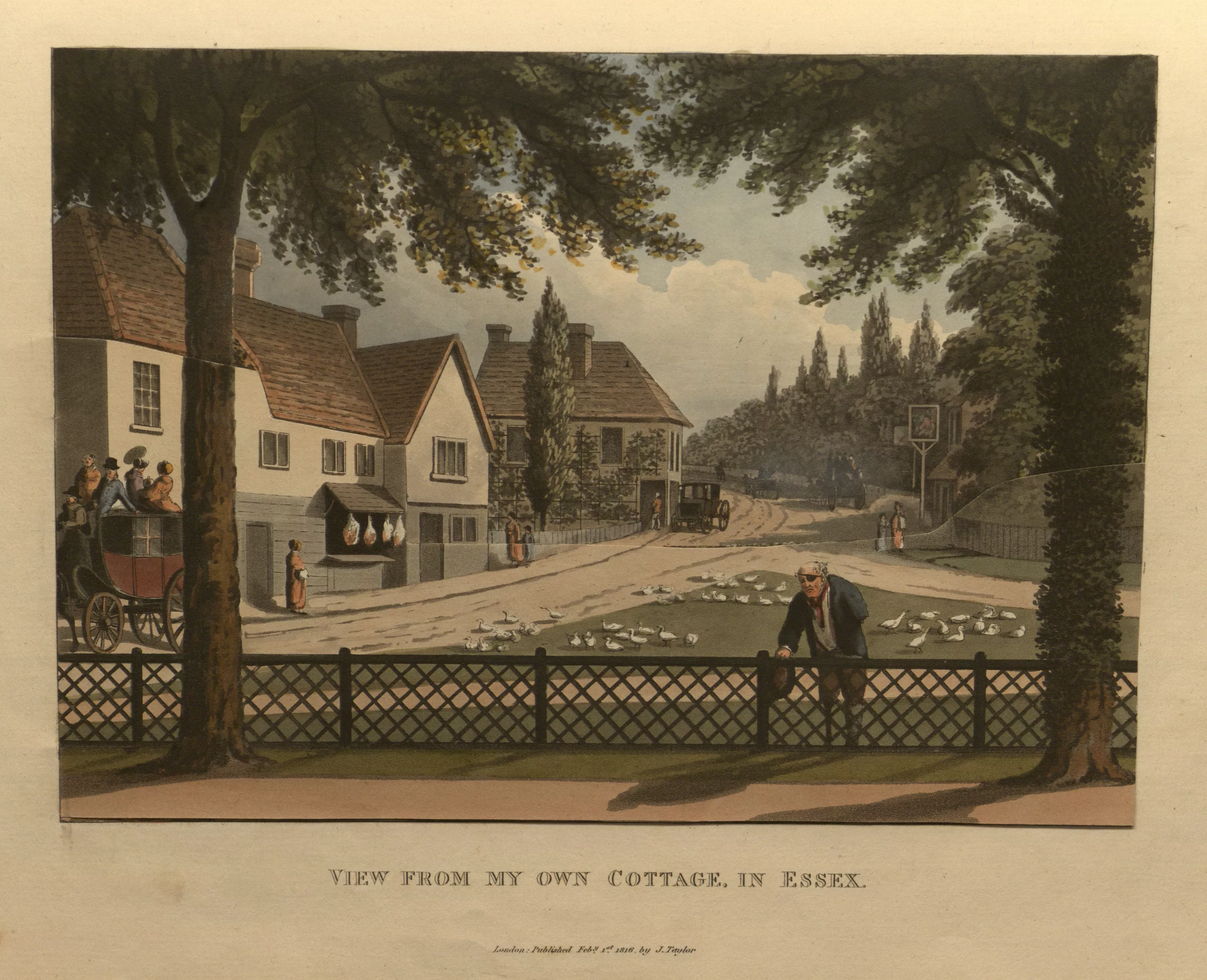Exhibit
Creation Date
1 February 1816
Height
17 cm
Width
24 cm
Medium
Genre
Description
Repton's lavishly illustrated texts served to record past accomplishments as wells as to advertise his skills as a landscape architect. The over-slips that allow for "before" and "after" views of a property were particularly important as they testified to the dramatic results Repton promised.
This image gives a view of a fork in the road, along which pedestrians and carriages travel. The road is lined with two-story buildings; hanging meat in a window and large signs suggest a commercial avenue. In the foreground, a lattice fence and two trees frame the view. A man with an eye patch, missing arm, and wooden leg leans against the foregrounded fence. In the mid-ground a triangular green space is populated by four dozen ducks.
This view of the road taken from Repton's own cottage, intended to demonstrate his landscaping skill, is further interesting for the changes that occur between the "before" and "after" images produced by the over-slip. When the over-slip is lifted, the viewer is treated to Repton's improvement of the landscape: the fence, ducks, and, most significantly, the disabled man disappear, and they are replaced by a trellis, flower garden, rose bushes, and a hedge fence. A chair and watering can occupy the foreground, and an additional trellis and shrubbery hide the view of the butcher’s shop.
Repton begins his commentary on the purposed improvement of his own property with the observation that during his long and active life, his efforts “have contributed to the happiness of some hundred individuals, and the employment of some thousands” (Repton 232). Yet, when faced with the unpleasant sight of a person likely in need of employment, he quickly eradicates the wandering “eye soar” from his vista. Notably, the man in question suffers from multiple injuries, and lacking the better portion of two limbs, would probably be unsuited to the landscaping work Repton’s projects provide. The violence of the old man’s erasure from Repton’s property is underscored by the empty chair with which he is replaced. This seat, which could provide the weary old traveler with needed respite, appears only after he is pointedly excluded from the landscape. Landscape designers such as Repton were able to control and reshape many aspects of their natural environment. However, it proved much harder to control the human element of a given landscape. Large tracks of private property could lessen the problem, but the unwanted sight of beggars, vagrants, or gypsies at the fringes of a property could never be fully avoided.
From 1814 until his sudden death in 1818, Humphry Repton retired to his Hare Street home, dedicating himself to his final treatise and memoir, Fragments on the Theory and Practice of Landscape Gardening (Daniels). Focusing on smaller projects, such as flower gardens, the volume ends with a view from Repton’s own window.
Collection
Accession Number
Thordarson T 4078
Additional Information
Bibliography
Daniels, Stephen. “Repton, Humphry (1752–1818).” Oxford Dictionary of National Biography. Ed. H. C. G. Matthew and Brian Harrison. Oxford: OUP, 2004. Web. 12 Mar. 2009.
Humphrey, Repton. Fragments on the Theory and Practice of Landscape Gardening. London: J. Taylor, 1816. Print.

